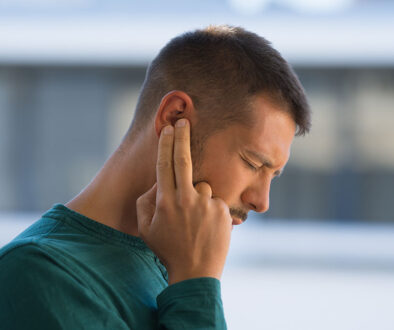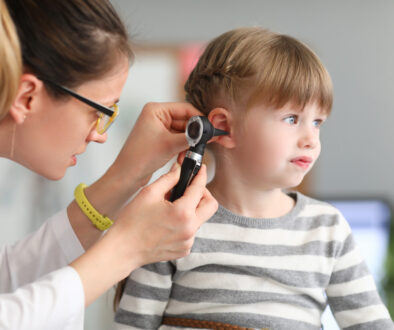The 4 Most Common Problems Affecting the Ears
In this article:
Maybe you hit the water the wrong way when diving off the side of the pool, and you’re now having pain in your ear. Perhaps you’re frustrated by ear infections that seem to happen constantly. These are a few of the common problems that can affect your ears and, in extreme cases, may even place your hearing at risk.
We’ll take a look at these issues, how they’re treated and what to do if you are experiencing ear problems.
Swimmer’s Ear
You’ve just finished a few laps in the pool but can’t shake the feeling of fluid in your ear.
No matter what you do, your ear remains “full.” Eventually, you develop the itching and pain that are telltale signs of swimmer’s ear.
We see water-related ear problems every year, most of which are entirely unavoidable and random. It can be confusing as a patient trying to decide whether an ear needs to be seen and how quickly that is necessary.
No one wants their time in the water to result in an uncomfortable condition like swimmer’s ear, so we’ve provided some useful tips to help you avoid this common ear infection.
Swimmer’s ear (also called acute otitis externa) occurs any time water stays in your ear canal for a long time, setting the stage for bacteria and germs to infect the delicate skin of your ear. It is essentially a localized infection in and on the skin of the ear canal, and it can involve bacteria or fungi.
While swimmer’s ear can occur any time of year—and by activities other than swimming—it’s often more common in the summer, when you and your children spend more time in the pool, ocean or lakes.
The most common causes of swimmer’s ear are germs that may be frequently found in water parks and in pools. According to the Centers for Disease Control, swimmer’s ear results in an estimated 2.4 million health care visits every year and nearly half a billion dollars in health care costs.
WHAT ARE THE SYMPTOMS OF SWIMMER’S EAR?
-
- Itching that comes from inside the ear.
- A “blocked” or “full” feeling, caused by fluid in the ear.
- Ear drainage.
- Fever.
- Difficulty hearing.
- Red and swollen skin near the ear.
Swimmer’s ear can also present more serious symptoms as it progresses, such as:
- Pus discharge.
- Swollen lymph nodes.
- Complete blockage of the ear canal.
- Intense pain in your face, neck and head.
If you suspect you have swimmer’s ear, it’s very important to get treatment from one of our physicians at Raleigh Capitol Ear, Nose and Throat. Delaying treatment can lead to a more serious ear infection or even hearing loss.
Bone and cartilage damage is also possible if you don’t seek treatment in a timely manner, according to information from the American Academy of Otolaryngology – Head and Neck Surgery.
7 USEFUL TIPS FOR PREVENTING SWIMMER’S EAR
There are several different ways you can help prevent swimmer’s ear:
- When swimming, keep your ears as dry as possible.
- Use a swim cap or ear plugs. We can also provide customized ear molds that can be used for swimming.
- Make sure to dry your ears thoroughly after swimming.
- Remember to use a towel and tilt your head with the ear facing downward to allow gravity to help water leave your ear canal. You can also gently pull your earlobe in different directions to encourage drainage. Do NOT use Q-tips or cotton swabs.
- Don’t swim in polluted water. If you use a pool or hot tub, be sure that the facility regularly disinfects it and checks the pH levels. This makes it less likely to spread germs. You may even decide to use your own pool test strips to check it for yourself if you’re not sure.
- Protect your earwax.What’s so important about earwax? It not only protects your ear canal from infection, but it helps keep water out of your ear. There’s no need to clean ear wax out of your ear—in fact, it normally moves through the ear on its own.
- Don’t put objects in your ear canal. How does this help you avoid swimmer’s ear? Objects such as cotton swabs, fingers or even pencils can scratch or irritate the skin of your ear. This irritation can provide an opening for bacteria.
Before you try any home remedies for swimmer’s ear, you should call us and schedule an appointment.
While pharmacies and retailers sell over-the-counter ear drops to help with swimmer’s ear, this is not the appropriate choice for everyone. In fact, drops should not be used by those with ear tubes or those who have had extensive damage to the eardrum.
If you have any ear drainage, please see us before using any over-the-counter remedies.
Traumatic Ear Injuries
During the summer, diving, body surfing and high-speed activities such as water skiing, can result in traumatic water injuries (especially to the eardrum). We see and treat them regularly.
Remember that the surface of a body of water (pool, lake or ocean) can effectively “slap” the ear when someone lands wrong, especially at greater speeds or from greater heights. The result is a pressure wave toward the eardrum, which can injure it.
This does not always produce a perforation or hole in the eardrum, but often it does. If an injury of this type is associated with lingering alteration of hearing, pain or drainage beyond 24 hours, it is wise to be seen by one of our specialists for a careful examination of the ears. Often, this will include an audiogram.
The vast majority of injured eardrums will heal on their own and do not require any treatment; however, the drum will occasionally require attention at the time of injury to avoid failed healing and a bigger procedure later.
A similar blow to the ear with associated significant dizziness can represent a far more serious condition requiring immediate attention.
While mild disorientation and brief dizziness may seem normal after wiping out on a wakeboard or with similar incidents, any severe and persistent dizziness should be evaluated as promptly as possible to be certain a potentially dangerous injury behind the eardrum has not occurred.
Fortunately, these more severe episodes are far less frequent.
Ear Wax Impaction
Cerumen (wax) impaction occurs when the external ear canal becomes blocked by an excessive amount of normally occurring wax. Cerumen is made by tiny glands in the outer aspect of the ear canal.
Earwax is considered gross and unappealing, so everyone makes an effort to keep ears clean. Most of the time, this involves a cotton “Q-tip”-type applicator. But did you know that ear, nose and throat doctors usually advise against using this method? Using cotton swabs could put your hearing at risk.
EARWAX GETS A BAD RAP
It’s not the most beautiful feature of your ears, but it enables them to hear beautiful music.
Earwax (its medical term is cerumen) has an important job. It’s responsible for cleaning, protecting and lubricating the ears. Its antibacterial properties enable earwax to serve as a self-cleaning agent. You may be surprised to learn that normally, ear canals shouldn’t be cleaned at all.
Earwax forms in the outer one-third of the ear canal. Chewing and jaw motion slowly moves earwax and skin cells to the ear opening, where they dry and fall out of the ear.
The earwax is never located in the deeper parts of the ear canal, such as near the eardrum. If left alone, earwax normally moves through its life cycle, causing no problems.
When you use cotton-tipped applicators, napkin corners or other objects, earwax is pushed deeper into the ear. The delicate membranes of the ear canal and eardrum can be easily irritated, placing your hearing in jeopardy.
Ear wax serves an important role in protecting the outer ear from moisture and other things which might enter the canal. In most people, the ear is self-cleaning and the wax will come out periodically on its own.
In others, cerumen may accumulate faster than it extrudes itself, leading to blockage and hearing loss or a feeling of fullness or pressure.
The most common cause of cerumen impaction is placing some object in the ear to try to remove the wax (Q-tip, bobby pin, or the top of a pen). In addition, water may sometimes get around the impacted cerumen and the warm and dark environment may lead to a bacterial or fungal infection.
Wax blockage is one of the most common causes of hearing loss. Blockage is often caused by cleaning the ear with cotton swabs and pushing the ear wax where it doesn’t belong. Most cleaning attempts merely push the wax deeper into the ear canal.
HOW TO PROPERLY REMOVE EAR WAX
Cleaning your ears is simple: wash the outside of the ear with a soft cloth, but do not place anything inside the ear canal. Home treatments may also help, such as over-the-counter ear drops or mineral oil. The ear may be irrigated by using a saline solution (remember to warm this to body temperature or you’ll get dizzy.)
Speak to us before you engage in any type of home remedy, including over-the-counter medications.
Do NOT use ear candles! They are dangerous and can lead to injuries such as burns and complete ear canal blockage.
Of course, the most effective way to remove impacted earwax is to schedule an appointment with an ENT doctor. These physicians can vacuum or remove the earwax using microscopic visualization. Another reason an ENT doctor is a good choice is that he or she may be able to determine if there are any problems with the structures of the ear and schedule follow-up appointments if necessary.
HOW ARE WAX IMPACTIONS TREATED?
As soon as you experience one of these impactions, contact us. We want to be sure that earwax is the cause of your hearing loss and not some more serious condition. If you have a history of cerumen impaction—and you do not have a hole in your eardrum— we can recommend some over-the-counter or prescription products.
Remember nothing smaller than your elbow or a football should be placed in your external ear canal!
Otitis Media, Also Known as a Middle Ear Infection
Middle ear infections can be painful for both children and adults. If not treated successfully, these persistent problems can cause permanent hearing damage.
Otitis media (ear infections) are very common in children—in fact, 3 out of 4 children will have an ear infection by the time they are three years old.
Because antibiotic-resistant bacteria are becoming more prevalent, antibiotics are not always successful when treating ear infections. In fact, antibiotics are typically not necessary. In some cases, these ear infections will go away on their own. (But remember it may take the fluid a month or longer to completely leave the ear.)
However, when you or your child experience chronic ear infections, ear tube placement may be a good option.
Ear tube placement—also referred to as a myringotomy –can be an effective treatment.
WHAT ARE EAR TUBES AND WHAT HAPPENS DURING A MYRINGOTOMY?
Ear tubes are small tubes that drain fluid from the middle ear, alieving pressure. They are also known as PE tubes or Pressure Equalization tubes. They are small, cylindrical silicone or plastic tubes that are surgically placed into the eardrum. They are inserted during a surgical procedure called a myringotomy with tube placement.
WHEN ARE EAR TUBES NECESSARY?
Ear tubes are typically placed for 4 reasons:
- Recurrent Otitis Media. This is the most common reason for ear tube placement for children between 1 and 6 years old. Tubes are generally considered for patients who are having five or more ear infections per year.
- Persistent Acute Otitis Media. Antibiotic-resistant bacteria are becoming more prevalent, and we are seeing more and more ear infections that will not clear with oral antibiotics. If an acute infection is not clearing with two to three courses of broad-spectrum antibiotics, ear tubes are frequently recommended.
- Otitis Media with Effusion. Middle ear fluid is common for several weeks following an ear infection. If however, fluid persists for three or more months, ear tubes are frequently recommended.
- Eustachian tube dysfunction. While most children will outgrow their tendency towards ear infections around the age of 6, some go on to have chronic Eustachian tube problems. This typically manifests as frequent middle ear fluid, ear pressure, and ear infections. Adults with these issues often have tubes placed to alleviate their symptoms.
HOW DO EAR TUBES WORK?
Ear tubes act as a ventilation device, preventing pressure build up behind the eardrum. In doing so, they prevent the build-up of fluid, thus minimizing the chance of developing an ear infection. Tubes also serve as a drain, allowing fluid or infection that is present at the time of surgery to be drained from the ear.
CAN I SWIM IF I HAVE EAR TUBES?
Yes. For bathing and swimming on the surface of a swimming pool, no precautions are necessary. For older children and adults who may dive deeper than two feet under water, ear plugs are recommended.
IS ANESTHESIA REQUIRED FOR TUBE PLACEMENT?
A brief, general anesthesia is required for tube placement in children. Adults can have ear tubes placed in an office setting using topical anesthesia (numbing drops on the eardrum).
Any post-surgical pain is usually well-controlled by over-the-counter medicines.
WILL I FEEL THE TUBES?
You or your child won’t be able to feel the tubes, but there should be significant relief from the fluid pressure. You may also find your child’s hearing has improved.
HOW LONG DO THE TUBES STAY IN THE EARDRUM?
In general, the tubes stay in place for approximately ten months and then fall out on their own. Ear drainage may occur after surgery.
A myringotomy is a safe procedure—in general, patients are fully recovered by the afternoon. Other benefits include a decreased need for antibiotics to treat infections, cost savings and fewer doctor visits.
We specialize in treating both adults and children, and we’ll be glad to answer any of your questions.
OTITIS MEDIA IN CHILDREN
Did you know that otitis media is the most common pediatric illness treated by ENTs?
While many children recover with no complications, otitis media can cause permanent hearing loss if it is left untreated. Hearing loss hinders learning ability and can even impede speech development. The severe pain associated with ear infections causes children—and their parents—distress.
Thankfully, timely and effective treatment can stop the pain and almost always restores hearing.
According to the Centers for Disease Control, some children are at greater risk of developing otitis media with effusion, Eustachian tube dysfunction, or persistent acute otitis media.
This includes children who:
- Are two years old or younger
- Attend daycare
- Drink from a bottle while lying down
- Are exposed to air pollution
- Are frequently around secondhand smoke
HOW CAN YOU TELL IF YOUR CHILD HAS AN EAR INFECTION?
Ear infections are one of the most common childhood illnesses, occurring even in infants. Often, children this young aren’t able to communicate what is causing them pain. So how can you tell if your baby or young child has an ear infection? Look for these signs:
- Pulling at ears
- Excessive crying
- Fluid draining from ears
- Problems with hearing
- Irritability, especially with infants and toddlers
- Difficulty balancing
- Sleep disturbances
- Fever
- Headache
Chronic ear infections are one of the most common conditions affecting children. Not only are they painful, but they can also cause long-term hearing damage. It’s always best to speak with one of our ear, nose and throat physicians in Raleigh who specialize in treating children.
Discover Why We Are the Premier Ear, Nose and Throat Doctors in Raleigh
Your hearing is a precious gift. Often, ear injuries or chronic infections can place your hearing in jeopardy, which is why it’s important for you or your child to seek treatment from one of our experienced physicians who are leaders in their field
For decades, we’ve offered the highest quality care for adults and children. Contact us for an appointment today.




